“If it bleeds, it leads” is the conventional wisdom regarding local TV news programming. But how real is the hype? And if it’s real, just how much blood are we talking about? Buckets? Boatloads? Mother-of-All-Boatloads?
The digital revolution hasn’t diminished the role TV news plays as a window to the world. For rural Americans — whose communities receive relatively little TV coverage — it’s a daily dose of urban life. For most media consumers, it’s their primary source for public affairs information. So what are they seeing? There are compelling reasons to measure the amount of crime coverage in nightly broadcasts relative to content about government, business, justice, culture, community, etc.
In 1996, The Memphis Flyer ran a cheeky cover package called “Guns & Bunnies.” We watched Memphis’ TV news broadcasts for a week to determine just how many minutes, on average, each station devoted to stories about violence, criminal activity, and disaster — a category we called “Guns.”
We also measured how much time each station devoted to fluffy news, such as celebrity-watching, cute animals, self-promotion, curiosities, and trivia — a category we called “Bunnies.” For this week’s issue, the Flyer staff recreated the original experiment, monitoring each of Memphis’ four news teams over four consecutive days. Minute-by-minute viewing diaries were kept, chronicling the headlines and the amount of time spent covering each story.
Memphis actually has five news stations: WMC-5, WREG-3, WHBQ-13, WATN-24, and WLMT-30. The last two constitute a duopoly under the same ownership, sharing a news team and content. To avoid redundancy and to measure similar half-hour news blocks, this survey looks only at the 10 p.m. broadcasts of WMC, WREG, WHBQ, and WATN.
The period between Tuesday, April 11th and Friday, April 14th was a relatively normal news week. Big national stories included the U.S. military action against Syria. Regional news included an attempt by Arkansas to step up the execution timeline for death row prisoners; a Memphis couple’s alleged racist vacation rant; and the Memphis Zoo naming its newborn hippo.
If the mayhem numbers reported below seem large, they may also be misleading and a little low, since not all chaos is created equal. It doesn’t get more violent than dropping something called “the mother of all bombs,” but that story was identified as U.S. foreign affairs. Similarly, some Arkansas death row reports revisited the crimes and victims of convicted felons, while others focused on celebrity protest.
These stories were treated as reporting on criminal justice, not criminal activity.
Now, without further delay — A BREAKING EXCLUSIVE FROM THE MEMPHIS FLYER: GUNS AND BUNNIES HAVE BEEN SPOTTED ALL OVER THE NIGHTLY NEWS!
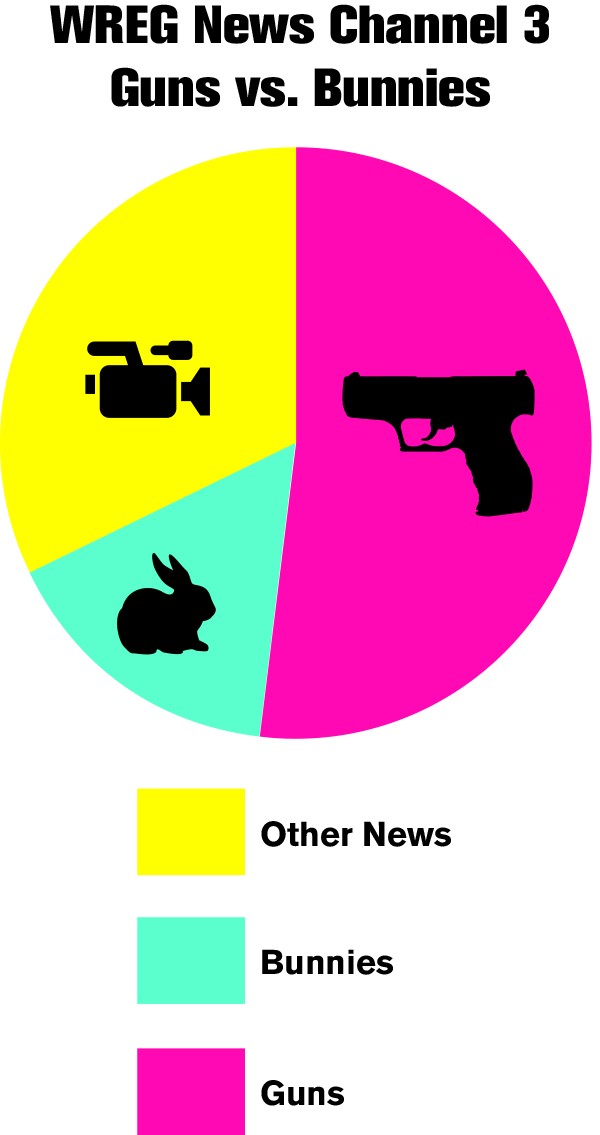

WREG News Channel 3 (Tribune Broadcasting)
Every night, WREG signs on with the old line “It’s 10 o’clock. Do you know where your children are?” And for good reason, given the reporting. Highlights from Tuesday’s broadcast included a truck crashing through apartments in Parkway Village, a woman shot while driving in Orange Mound, an Arkansas machete attack, an exploding ammo plant in Missouri, and mysterious lights in the sky over San Diego. A four-minute teen violence package covered a Binghampton murder, a shooting in Tom Lee Park, and a North Memphis shooting broadcast that was on Facebook Live. Tuesday’s broadcast also covered the story of a sick Midtown kid who’s getting a trip to Disneyworld and included the popular segment, “Pass It On,” wherein Richard Ransom gives money to people who need it.
Wednesday’s broadcast began with gunshots at a North Memphis community center, followed by reports about an Arkansas man who set his wife on fire and a deadly explosion in Lakeland. Also covered: bullets in a barber shop in Arizona; microchips being installed in people in Sweden; a 9-year-old driving himself to McDonald’s in Ohio; and a fight between a horse and an alligator in Florida. (The horse won, by the way.)
Thursday’s broadcast led with a young child left at home, followed by a man charged with murder in Hickory Hill, three people killed in a Benton County car crash, and a woman who was carjacked at First Congo church. On the less grim side, a miniature goat saved a family from a house fire in Arkansas, and a Wisconsin girl grew a 35-pound cabbage!
Friday’s broadcast was almost half sports reporting. Other stories included an armed robbery at the Midtown TitleMax and a report about flowers in California.
Based on a four-day sample, WREG devoted 43 percent of its weeknight 10 p.m. broadcast to news, 10 percent to weather, 15 percent to sports, and 3 percent to teasers. The roughly half-hour blocks were rounded out by ads (29 percent).
Around 52 percent of the news content was related to crime, violence, mayhem, and disaster — earning a “guns” rating. Nearly 16 percent of news content was devoted to celebrities, trivia, novelty stories, and fluffy feel-good pieces — earning a “bunnies” rating. The remaining 32 percent of WREG’s news programming covered stories that didn’t scream, bleed, or wiggle their nose, such as government, business, development, and education.

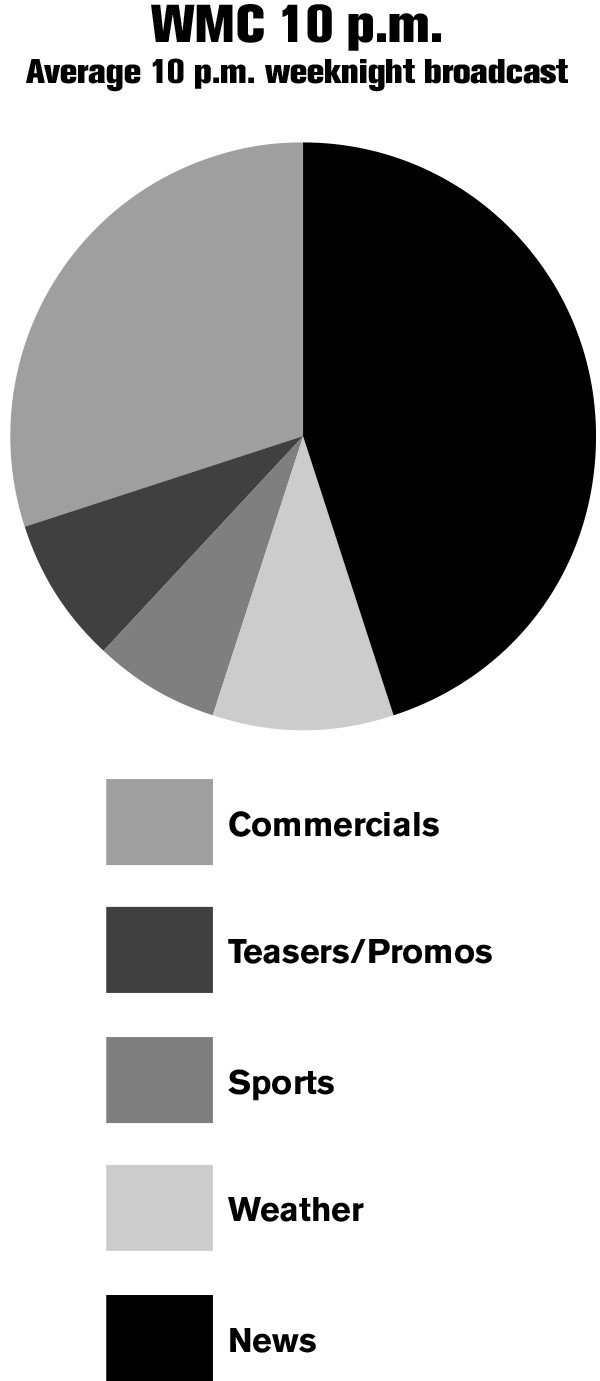
WMC Action News 5 (Raycom)
Tuesday started with a bang: A woman was taken to the hospital after being shot on East Parkway; a recently baptized teen shot another teen; and then there was that shooting on Facebook Live. The story of Arkansas’ attempt to launch a mass execution of death row inmates took a celebrity turn, as WMC focused on former death row inmate Damien Echols. Other stories included metered parking rates going up and the death of J. Geils Band’s lead guitarist. WMC also reported on the Civil War’s “controversial” Fort Pillow massacre of African Americans
by Confederate soldiers, without mentioning commanding officer Nathan Bedford Forrest.
WMC consumer advocate Andy Wise and a group of big-hearted contractors renovated a disabled American veteran’s garage after he was ripped off by shoddy workmen. And every night, a WMC anchor pitches to Jimmy Fallon for a Tonight Show promo. Closing anchor chatter included a tease for women with “coffee problems.”
WMC’s Wednesday broadcast got under way with stories about a teen beaten by West Memphis police and a mother shot while driving, followed by reports on the settlement of a lawsuit against Christian Brothers High School for not allowing a student to bring his same-sex date to the prom, code violations that plagued a new Midtown hotspot, comedian Charlie Murphy’s death, an Ole Miss fan’s traffic ticket woes, and someone who was shot and carjacked in downtown Memphis.
On Thursday, WMC led with a story about an infant who was left at home unattended, followed by a story on West Memphis police breaking their silence on a teen beating, police responding to reports of shots at Superlo, a family wanting answers about their son, who was found dead in a creek, “a mom” who allegedly killed two sisters in Hickory Hill, the Memphis Zoo’s new baby hippo, and a multi-vehicle crash in Durango, Texas.
“Arkansas calls off executions,” led Friday night’s broadcast, followed by a Memphis couple’s alleged racist vacation rant/viral sensation, a story of a 12-year-old shot, an armed robbery, and a fatal hit-and-run in Raleigh. Other stories included abortion restrictions, Beale Street Bucks returning, the Grizzlies giving away gear, thieves stealing an Arkansas woman’s statue of Jesus, a three-minute package about the 2011 murder of Holly Bobo, and a professional athlete surprising a young cancer patient.
In our four-day sample, WMC devoted 45 percent of its weeknight 10 p.m. broadcast to news, 10 percent to weather, 7 percent to sports, and 8 percent to teasers. Advertising filled roughly 30 percent of the broadcasts.
Around 47 percent of WMC’s news content was “guns” — crime, violence, mayhem, and disaster; 20 percent of its news content was “bunnies” — stories devoted to celebrities, trivia, novelty, and fluffy feel-good pieces. About 33 percent of WMC news programming covered stories that didn’t scream, bleed, or deliver candy to children on Easter.

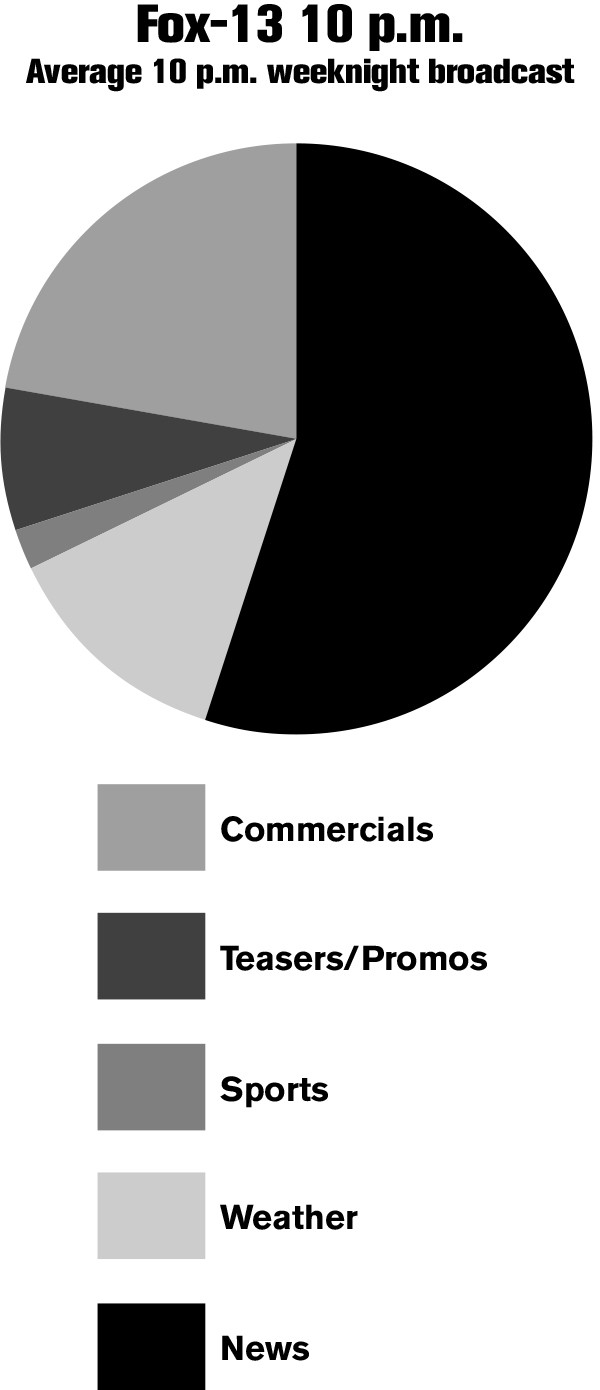
WHBQ Channel 13
(Cox Enterprises)
While Fox 13 devotes much of its on-air time to mayhem, WHBQ also seems to have fewer commercials and uses the extra time to touch on a broader mix of local stories about local government and other non-crime-related news.
Tuesday began with a weather update, then went right into the shooting on Facebook Live, followed by a story about a Memphis teenager facing charges after shooting another teen, Overton Park Greensward parking, MATA improvements, and a Memphis Police Department audit.
Wednesday kicked off with police brutality in West Memphis, followed by a package about the planned execution of death row inmates in Arkansas. Crime reporting continued with the rape of a minor in Arkansas, a Rutherford County shooting, and a man breaking into cars.
WHBQ led off Thursday with a story about Tennessee’s weed bill, followed by pieces about adults getting free tuition for community college, the U.S. MOAB bomb in Afghanistan, a non-critical shooting in Orange Mound, the Tennessee Senate passing a new age requirement for school bus drivers, and Toyota expanding in Mississippi.
“Arkansas blocks lethal drug in execution” got Friday started, followed by stories about two shootings in Tom Lee Park, a man robbed at a fraternity house, buildings on fire in Nashville, and a Murfreesboro couple charged with neglecting to feed their baby. A report on local refugees was followed by the story of a Mississippi family facing deportation.
Based on our four-day sample, Fox 13 devoted 55 percent of its weeknight 10 p.m. broadcast to news, 13 percent to weather, 2 percent to sports, and 8 percent to teasers. Advertising filled the remaining 22 percent of air time.
WHBQ’s “guns” rating was 48 percent: content related to crime, violence, mayhem, and disaster. “Bunnies” stories — celebrities, trivia, novelty, and feel-good fluff — comprised 8 percent of the station’s news content. Nearly 44 percent of Fox’s news programming covered stories that didn’t scream, bleed, or taste delicious when fried in a light batter and served with tangy mustard sauce.


WATN Local 24 (Nexstar Media Group)
Based on our sample, WATN-24 (formerly WPTY) appears to have the highest percentage of mayhem in the Memphis market. In fact, among Memphis stations, Channel 24 seems to devote the least amount of time to news reporting.
WATN begins its weeknight broadcasts with a weather update. Tuesday’s opening news roundup covered road rage and a pop-up park, a Cookeville shooting, a Memphis chocolatier appearing in British Vogue, a local salon that’s pampering kids who make good grades, and a safety alert about Tom Lee Park.
Following weather and its headline roundup, Wednesday’s newscast began with a story about the identification of a body found in a car trunk, followed by the Shelby County Commission addressing sewage backups in Cottonwood, a propane tank exploding in California, and a Mississippi video of a fight at Alcorn State that went viral. Other stories included the Tennessee Department of Transportation suspending work for Easter, Ole Miss football coach Hugh Freeze being protested by an atheist group, and a Bartlett woman who turned 100.
Thursday’s broadcast began with news that violent crime is up in Memphis, and with two sisters being killed in Hickory Hill. Those stories were followed by Shelby County officials warning faith-based organizations celebrating the Passover and Easter holidays to be on high alert, a Target recall of potentially dangerous Easter toys, and Loretta Lynn’s new record.
“Jesus Stolen” and “Sisters Murdered” were the two stories starting Friday’s news block, followed by the Memphis couple’s alleged racist rant, a boy recovering at Le Bonheur after being shot, Delta Airlines paying for overbooked flights, and a stay of execution for Arkansas prisoners, featuring star power mentions of Johnny Depp and Damien Echols.
Based on our sample, Local 24 devoted 28 percent of its weeknight 10 p.m. broadcast to news, 13 percent to weather, 14 percent to sports, and 6 percent to teasers. The station’s ad content was 39 percent.
Local 24 earned a 60 percent “guns” rating — news content concerning crime, violence, mayhem and disaster. Around 25 percent of the station’s news content was “bunnies” — stories about celebrities, trivia, novelty, and fluffy feel-good pieces. About 15 percent of its news programming covered stories that didn’t scream, bleed, or hop around and serve as an easy metaphor for an overactive libido.
So that was the Memphis television news, as surveyed between April 11th and April 14th, 2017. To say the least, our news stations painted a rather dystopian picture of life in Memphis, focusing heavily on crime, violence, and mayhem, while stirring in lots of stories to make us say “aw” or “wow!”
If all of Memphis’ major stations were rolled up into one big news broadcast, 50.6 percent of their average news content would be “guns,” and 16 percent would be “bunnies.” Only about a third of local news programming covers stories that are neither.
Is it any wonder lots of people have a skewed view of life in Memphis?
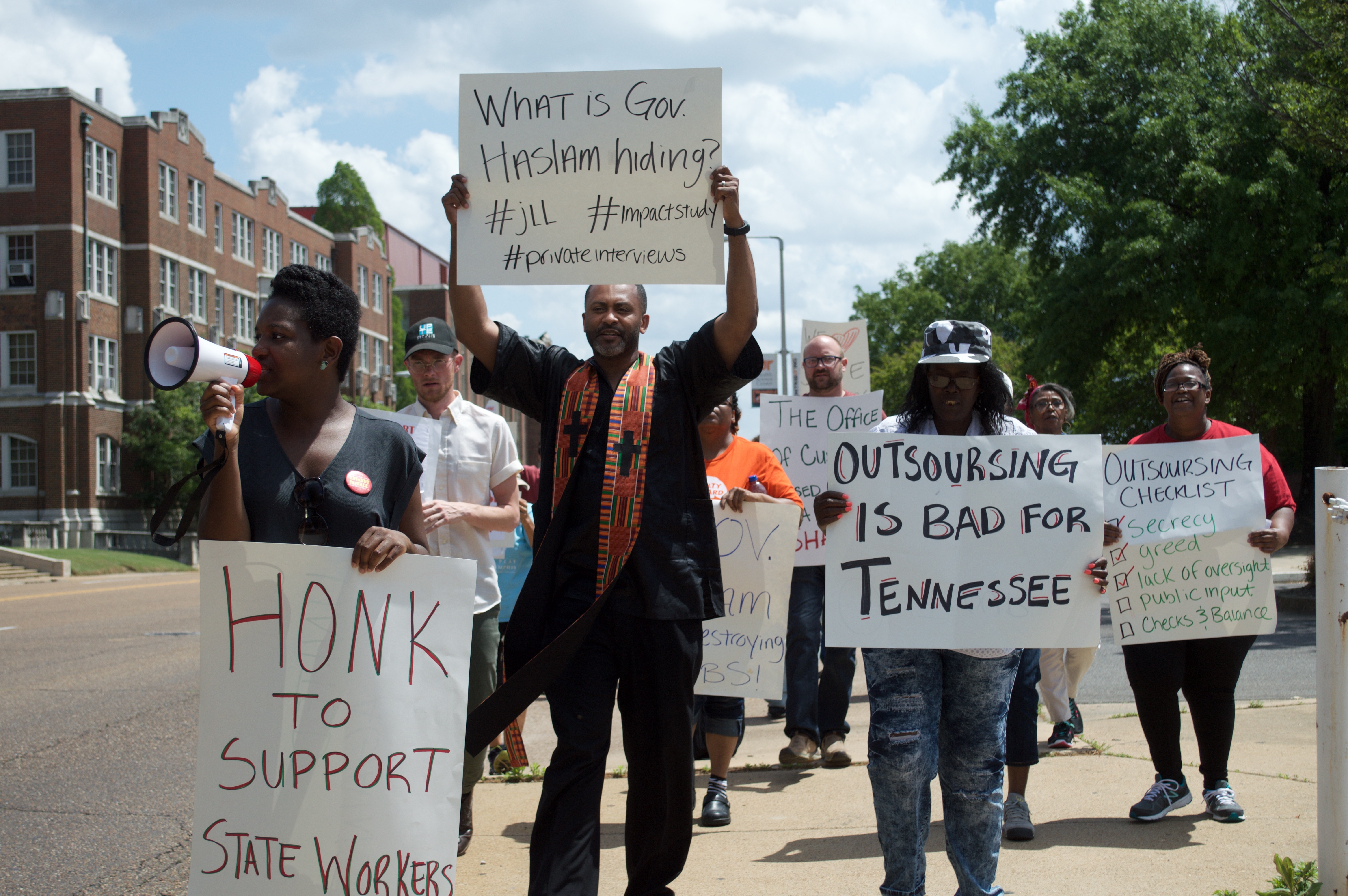 Micaela Watts
Micaela Watts 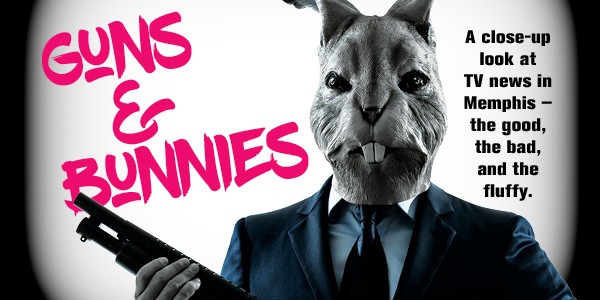


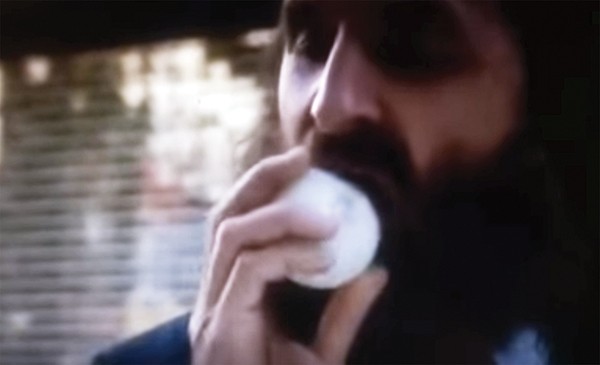










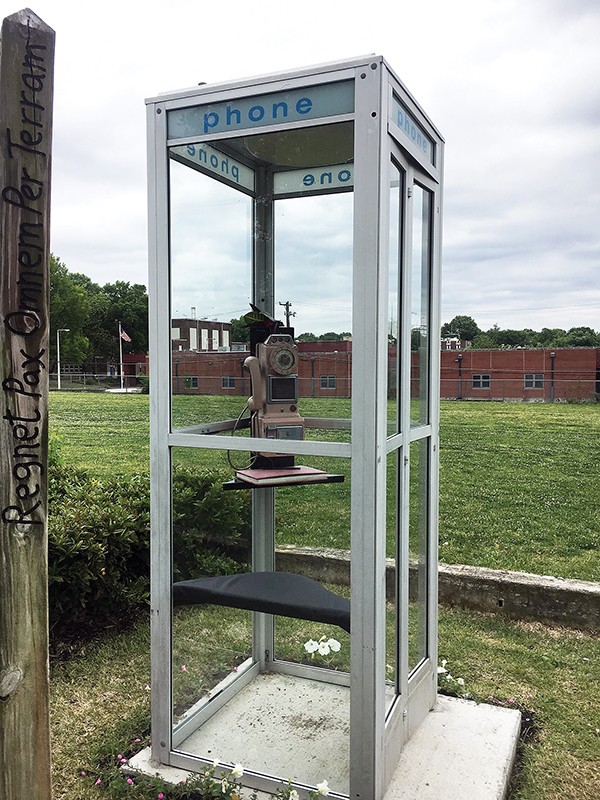 Maya Smith
Maya Smith